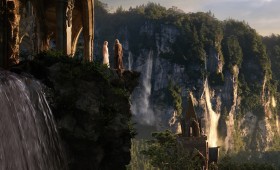It’s wonderful to be
back in Middle Earth
 So does it live up to all the hype and hoopla? And then
some. Was it faithful to The Hobbit
as set forth by J. R. R. Tolkien? Well…as much as can be cinematically
expected. Some characters were missing,
like the woodsman/bear guy. And some from the LOTR trilogy were thrown in for
continuity, like Frodo, Galadriel and Saruman. But in the hands of Peter Jackson, the
experience was pure Tolkien.
So does it live up to all the hype and hoopla? And then
some. Was it faithful to The Hobbit
as set forth by J. R. R. Tolkien? Well…as much as can be cinematically
expected. Some characters were missing,
like the woodsman/bear guy. And some from the LOTR trilogy were thrown in for
continuity, like Frodo, Galadriel and Saruman. But in the hands of Peter Jackson, the
experience was pure Tolkien. For Bilbo Baggins, tucked into his homey Hobbit hole with
his pipe and well-stocked larder, the adventure begins when he’s singled out by
a wizard called Gandalf to act as a burglar. A burglar? That isn’t well
explained in this first installment. The Hobbit is small, quiet, resourceful
and, well, unexpected. The dwarves’ quest, which Gandalf is aiding, will at
some point need some extreme sneakery. And
Bilbo fills the bill. The whole thing is hardly fair to Bilbo, but for some
reason Gandalf feels he needs to see a bit more of the world. You know - experience
hideous orcs, assorted goblins, wargs, stone giants and the like.
For Bilbo Baggins, tucked into his homey Hobbit hole with
his pipe and well-stocked larder, the adventure begins when he’s singled out by
a wizard called Gandalf to act as a burglar. A burglar? That isn’t well
explained in this first installment. The Hobbit is small, quiet, resourceful
and, well, unexpected. The dwarves’ quest, which Gandalf is aiding, will at
some point need some extreme sneakery. And
Bilbo fills the bill. The whole thing is hardly fair to Bilbo, but for some
reason Gandalf feels he needs to see a bit more of the world. You know - experience
hideous orcs, assorted goblins, wargs, stone giants and the like.  Quest stories are always fraught with possibilities:
reversals, revelations, cliff-hanging dangers, unexpected encounters, you name
it. This tale has it in spades. The special appeal of this one is that the main
character, Bilbo the Hobbit, has the fortitude to rise up with sword in hand
when he absolutely must. But he remains the genuine, unassuming little homebody
that he was before setting out.
Quest stories are always fraught with possibilities:
reversals, revelations, cliff-hanging dangers, unexpected encounters, you name
it. This tale has it in spades. The special appeal of this one is that the main
character, Bilbo the Hobbit, has the fortitude to rise up with sword in hand
when he absolutely must. But he remains the genuine, unassuming little homebody
that he was before setting out.
There’s a lot of warmth in this action-plus movie. As before,
it’s set in the breathless panoramic beauty of New Zealand. You want to see
this. We all need a little Middle Earth in our souls.













































